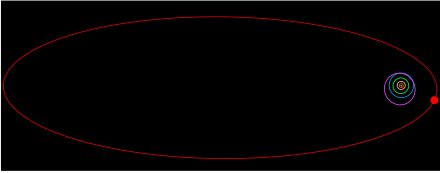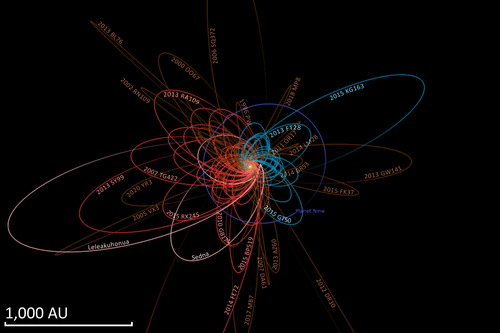|
List of Solar System objects by greatest aphelion
 This is a list of Solar System objects by greatest aphelion or the greatest distance from the Sun that the orbit could take it if the Sun and object were the only objects in the universe. It is implied that the object is orbiting the Sun in a two-body solution without the influence of the planets, passing stars, or the galaxy. The aphelion can change significantly due to the gravitational influence of planets and other stars. Most of these objects are comets on a calculated path and may not be directly observable.[1] For instance, comet Hale-Bopp was last seen in 2013 at magnitude 24[2] and continues to fade, making it invisible to all but the most powerful telescopes. The maximum extent of the region in which the Sun's gravitational field is dominant, the Hill sphere, may extend to 230,000 astronomical units (3.6 light-years) as calculated in the 1960s.[3] But any comet currently more than about 150,000 AU (2 ly) from the Sun can be considered lost to the interstellar medium. The nearest known star is Proxima Centauri at 269,000 AU (4.25 ly),[4] followed by Alpha Centauri at about 4.35 light years.[4] Oort cloud comets orbit the Sun at great distances, but can then be perturbed by passing stars and the galactic tides.[5] As they come into or leave the inner Solar System they may have their orbit changed by the planets, or alternatively be ejected from the Solar System.[5] It is also possible they may collide with the Sun or a planet.[5] S/2021 N 1 (the outermost moon of Neptune) takes over 27 years to orbit Neptune, comets can take up to 30 million years to orbit the Sun, and the Sun orbits the Milky Way in about 230 million years (a galactic year).
ExplanationBarycentric vs heliocentric orbits As many of the objects listed below have some of the most extreme orbits of any objects in the Solar System, describing their orbit precisely can be particularly difficult and sensitive to the time the orbit is defined at. For most objects in the Solar System, a heliocentric reference frame (relative to the gravitational center of the Sun) is sufficient to explain their orbits. However, as the orbits of objects become closer to the Solar System's escape velocity, with long orbital periods on the order of hundreds or thousands of years, a different reference frame is required to describe their orbit: a barycentric reference frame. A barycentric reference frame measures the asteroid's orbit relative to the gravitational center of the entire Solar System, rather than just the Sun. Mostly due to the influence of the outer gas giants, the Solar System barycenter varies by up to twice the radius of the Sun. This difference in position can lead to significant changes in the orbits of long-period comets and distant asteroids. Many comets have hyperbolic (unbound) orbits in a heliocentric reference frame, but in a barycentric reference frame have much more firmly bound orbits, with only a small handful remaining truly hyperbolic. Eccentricity and VinfThe orbital parameter used to describe how non-circular an object's orbit is, is eccentricity (e). An object with an e of 0 has a perfectly circular orbit, with its perihelion distance being just as close to the Sun as its aphelion distance. An object with an e of between 0 and 1 will have an elliptical orbit, with, for instance, an object with an e of 0.5 having a perihelion twice as close to the Sun as its aphelion. As an object's e approaches 1, its orbit will be more and more elongated before, and at e=1, the object's orbit will be parabolic and unbound to the Solar System (i.e. not returning for another orbit). An e greater than 1 will be hyperbolic and still be unbound to the Solar System. Although it describes how "unbound" an object's orbit is, eccentricity does not necessarily reflect how high an incoming velocity said object had before entering the Solar System (a parameter known as Vinfinity, or Vinf). A clear example of this is the eccentricities of the two known Interstellar objects as of October 2019, 1I/'Oumuamua. and 2I/Borisov. 'Oumuamua had an incoming Vinf of 26.5 kilometres per second (59,000 mph), but due to its low perihelion distance of only 0.255 au, it had an eccentricity of 1.200. However, Borisov's Vinf was only slightly higher, at 32.3 km/s (72,000 mph), but due to its higher perihelion distance of ~2.003 au, its eccentricity was a comparably higher 3.340. In practice, no object originating from the Solar System should have an incoming heliocentric eccentricity much higher than 1, and should rarely have an incoming barycentric eccentricity of above 1, as that would imply that the object had originated from an indefinitely far distance from the Sun. Orbital epochsDue to having the most eccentric orbits of any Solar System body, a comet's orbit typically intersects one or more of the planets in the Solar System. As a result, the orbit of a comet is frequently perturbed significantly, even over the course of a single pass through the inner Solar System. Due to the changing orbit, it's necessary to provide a calculation of the orbit of the comet (or similarly orbiting body) both before and after entering the inner Solar System. For example, Comet ISON was ~312 au from the Sun in 1600, and its remnants will be ~431 au from the Sun in 2400, both well outside of any significant gravitational influence from the planets. Comets with greatest aphelion (2 body heliocentric) 
Distant comets with long observation arcs and/or barycentric Examples of comets with a more well-determined orbit. Comets are extremely small relative to other bodies and hard to observe once they stop outgassing (see Coma (cometary)). Because they are typically discovered close to the Sun, it will take some time even thousands of years for them to actually travel out to great distances. The Whipple proposal might be able to detect Oort cloud objects at great distances, but probably not a particular object.
Minor planets
A large number of trans-Neptunian objects (TNOs) – minor planets orbiting beyond the orbit of Neptune – have been discovered in recent years. Many TNOs have orbits that take them far beyond Pluto's aphelion of 49.3 AU. Some of these TNOs with an extreme aphelion are detached objects such as 2010 GB174, which always reside in the outermost region of the Solar System, while for other TNOs, the extreme aphelion is due to an exceptionally high eccentricity such as for 2005 VX3, which orbits the Sun at a distance between 4.1 (closer than Jupiter) and 2200 AU (70 times farther from the Sun than Neptune). The following is a list of minor planets with the largest aphelion in descending order.[16] Minor planets with a heliocentric aphelion greater than 400 AUThe following group of bodies have orbits with an aphelion above 400 AU, with 1-sigma uncertainties given to two significant digits. As of May 2024, there are 73 such bodies.[16] 
Greatest barycentric aphelionThe following asteroids have an incoming barycentric aphelion of at least 1000 AU.[citation needed]
Comparison See also
References
External links |
Portal di Ensiklopedia Dunia